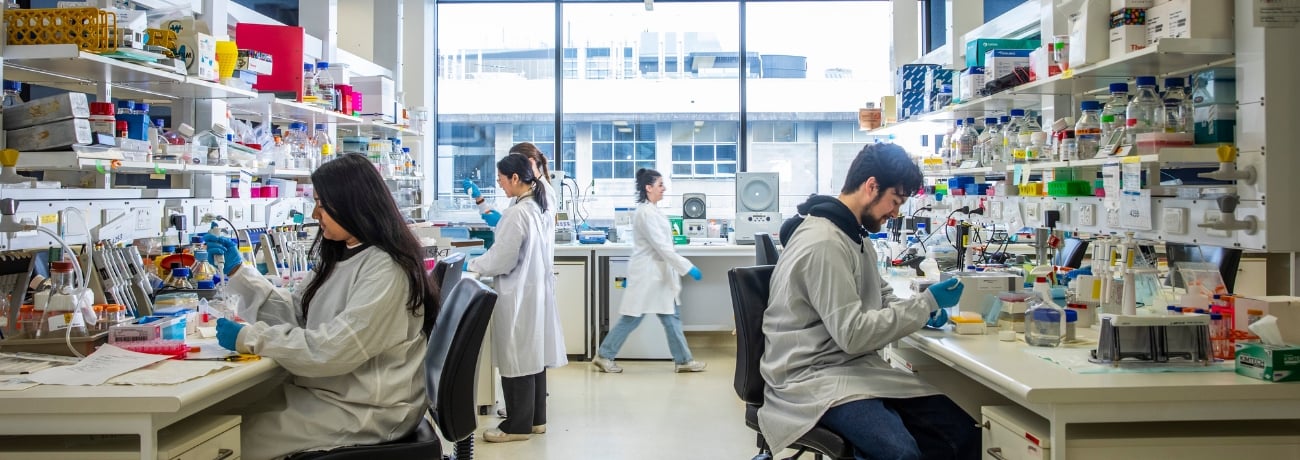Autonomic Neuroscience Group
We study the ‘housekeeping’ parts of the brain that control the body’s functions, like heart rate and temperature regulation. These control circuits are mostly in the hypothalamus and the brain stem.
Autonomic nerves are the unconscious pathways that connect these circuits to every organ in the body, and they’re essential to keeping us healthy. They contain many subtypes, each of which has specific connections and specific functions. Examples are pathways that slow or accelerate the heart rate, those that regulate the blood flow to the kidney, those that regulate sweating for body temperature control as well as those that regulate the stomach and the bladder.
Our research investigates the dedicated groups of brain cells responsible for controlling these functions. Currently, we’re focusing on the brain stem neurons and autonomic nerve pathways that communicate with the immune system.
Research interests
|
Techniques
|
About our research
We analyse the neural pathways of the inflammatory reflex. This is an unconscious reflex that regulates systemic inflammation in a negative feedback fashion. Inflammation is the first stage of the body’s response to injury or microbial invasion. It’s both good and bad; it’s necessary to mobilise immune defences but, if too intense, it can damage host tissues and endanger recovery.
The brain stem has evolved a mechanism that automatically helps to lessen the inflammatory response to an immune challenge and keep it within controllable limits. This mechanism dampens down the levels of pro-inflammatory cytokine hormones such as tumour necrosis factor (TNF), interleukin 6 and interferon-gamma, but at the same time, it enhances levels of the anti-inflammatory cytokine interleukin 10. We discovered that the output pathway from the brain to body runs in the splanchnic sympathetic nerves. If we cut these nerves to disable the reflex, the inflammatory response to the immune challenge is much stronger. This dampening effect of the inflammatory reflex can be seen to operate within minutes, but its consequences persist for a day or more.
Through our research, we are trying to define the central neurons that mediate the inflammatory reflex. So far, we have found that it is mediated from within the brain stem but does not require the hypothalamus.
A second line of study is identifying the neurochemical ‘signature’ of sympathetic ‘immuno-efferent’ neurons, using single-cell RNA analysis.
A third area of study is to try to understand the significance of this reflex for human health. We’ve already found that it plays an important role in the body’s ability to clear a systemic bacterial infection (sepsis). We are also investigating how the reflex affects antibody and cellular immune responses over the longer term (adaptive immunity).
Research projects
- Neuroendocrine regulation of salt and water balance
- Regulation of the immune system by the brain
- The inflammatory reflex and neuro-immune connections
Research team
Team member
Melinda Goga
Research Assistant
Selected publications
- McKinley MJ, Martelli D, Trevizan‐Baú P and McAllen RM (2022), ‘Divergent splanchnic sympathetic efferent nerve pathways regulate interleukin‐10 and tumour necrosis factor‐α responses to endotoxaemia’, The Journal of Physiology, 600(20):4521–4536, doi:10.1113/jp283217
- McAllen RM, McKinley MJ and Martelli D (2022), ‘Reflex regulation of systemic inflammation by the autonomic nervous system’, Autonomic Neuroscience, 237:102926, doi:10.1016/j.autneu.2021.102926
- Lankadeva YR, May CN, McKinley MJ, Neeland MR, Ma S, Hocking DM, Robins-Browne RM, Bedoui S, Farmer DM, Bailey S, Martelli D and McAllen RM (2020), ‘Sympathetic nerves control bacterial clearance’, Scientific Reports, 10(1), doi:10.1038/s41598-020-72008-4
- Occhinegro A, Wong CY, Chua BY, Jackson DA, McKinley MJ, McAllen RM and Martelli D (2021), ‘The endogenous inflammatory reflex inhibits the inflammatory response to different immune challenges in mice’, Brain Behavior and Immunity, 97:371–375, doi:10.1016/j.bbi.2021.07.019
- Martelli D, Yao ST, McKinley MJ and McAllen RM (2014), ‘Reflex control of inflammation by sympathetic nerves, not the vagus’, The Journal of Physiology, 592(7):1677–1686, doi:10.1113/jphysiol.2013.268573
Contact us
For more information about our group’s research you can contact us by submitting this form.
